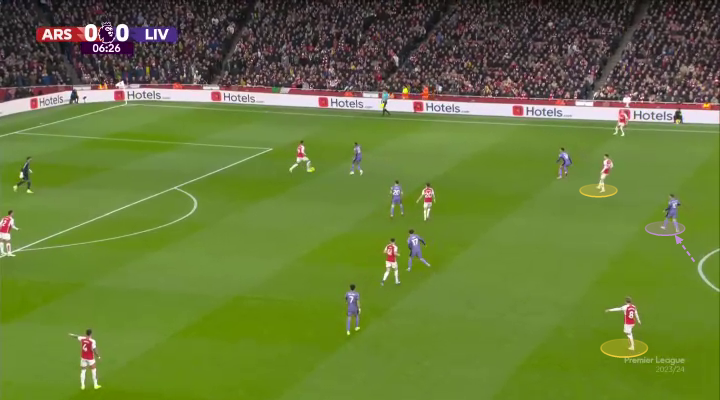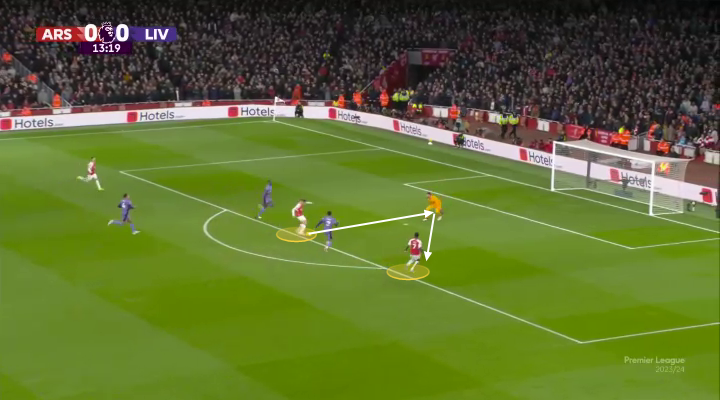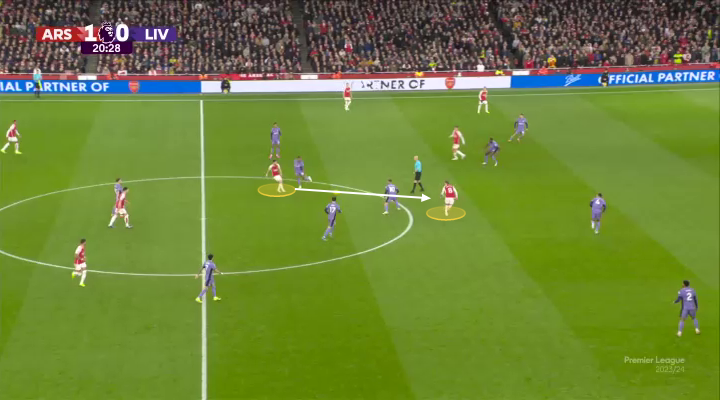A month ago, Jurgen Klopp complimented Mikel Arteta’s tactical approach, even as Arsenal were eventually eliminated by Liverpool in the FA Cup third round.
“It is difficult to prepare for what Arsenal did tonight, especially in the first half,” Klopp said. “Kai Havertz and Martin Odegaard, more or less as ‘double 10s’ in a 4-2-2-2.”
So, for Sunday’s league fixture, Arteta did the same again.
This was the basic pattern of the game. Liverpool’s 4-3-3 system was 4-1-4-1 out of possession, with Curtis Jones and Ryan Gravenberch responsible for closing down Arsenal’s deep midfielders, Declan Rice and Jorginho. At the top of Arsenal’s box midfield, Havertz played in the left channel and Odegaard in the right channel. They were on either side of Alexis Mac Allister, who constantly faced a decision about who to close down.
When Rice received possession here, he should have slipped the ball through Liverpool’s midfield quickly to feed Odegaard.

Odegaard had already received possession in that zone, within the first couple of minutes.

This became the theme of the first half. In this move, once again, Havertz and Odegaard are between the lines, in wide positions. Mac Allister looks to close down Havertz, who is closer to the ball, which leaves Odegaard in oceans of space, shouting for a pass.

At times, Liverpool attempted to man-mark in midfield, which was a dangerous approach with a deficit in midfield. Here, Jones is keeping an eye on Rice, Gravenberch is next to Jorginho, and Mac Allister is closely following Odegaard. That left Havertz as the fourth man, looking over his shoulder to check the position of Liverpool’s defenders and ensure he remained between the lines.

As the move continues and Arsenal switch play, Mac Allister moves across to close down Havertz.

That, in turn, left Odegaard free.

So, based upon the opening to the game, it seemed clear Liverpool were struggling in that zone. Arsenal’s opener, when it arrived, brilliantly exploited their numerical advantage in midfield.
When Gabriel plays the ball out to Oleksandr Zinchenko, Mac Allister is towards that side, closing down Havertz.

That, once again, left Odegaard free. Zinchenko moves inside and plays a square pass to him, while Mac Allister tracks Havertz’s run.

Mac Allister, realising that Odegaard is free, stops marking Havertz. But this worked out brilliantly for Arsenal — Odegaard has positioned himself perfectly, with the result that Virgil van Dijk cannot move towards him quickly enough. Mac Allister is caught in no man’s land, allowing Havertz to go free. And because Trent Alexander-Arnold has moved up to close down Zinchenko, Ibrahima Konate is too wide, creating a huge gap for Havertz to sprint into.

Havertz’s major shortcoming is his inconsistent finishing, and this wasn’t the most convincing effort. But Bukayo Saka was on hand to turn in the rebound. That scrappiness aside, it was a brilliant move.

The pattern continued, although Arsenal couldn’t quite match the run and pass in the final third. Here is another example of Odegaard finding space as Mac Allister is towards the opposite side, with Van Dijk too late to tackle him.

Havertz should probably have been making a run across the face of Konate, but Odegaard finds him with a square ball instead.

Odegaard’s positioning and movement were brilliant throughout the first half. Here, Mac Allister thinks he’s covered the passing lane between Jorginho and Odegaard, but Odegaard points and then runs in behind him, confident that Jorginho can play the right pass.

Jorginho duly plays it perfectly to the Odegaard.

Gabriel Martinelli should probably have been making his trademark run on the shoulder of the last defender — he’s a little late, and Odegaard can only pass to him in a wide position, rather than for a goalscoring chance.

Jorginho deserves special praise for an excellent midfield performance — this ball into Havertz shortly before Liverpool’s equaliser wasn’t really related to the tactical battle, but showed the precision in his passing.

That was obvious after the break, too. At half-time, Klopp reshaped, moving Jones deeper alongside Mac Allister, to prevent the Argentinian from being dragged from side to side.

But even when Liverpool closed the spaces around Odegaard, Jorginho was still adept at feeding passes into him.


So if Odegaard and Havertz were playing as No 10s, where did the running in behind come from?
Well, out wide Martinelli and Saka knew their job — to provide speed and directness. This move, at 0-0, would have been a perfect demonstration — it came straight from a David Raya throw, and while Saka was under pressure from Joe Gomez, it was essentially a point-blank header with an open goal gaping.


After three meetings in just six weeks — two in the league, one in the FA Cup — the aggregate score between Arsenal and Liverpool is 4-4. Liverpool are still two points ahead in the Premier League table.
But Arteta has underlined his tactical acumen in the most recent two fixtures between the sides. And it’s fair to ask: if Klopp knew what might be coming, why were his side so exposed?
Read the full article here


